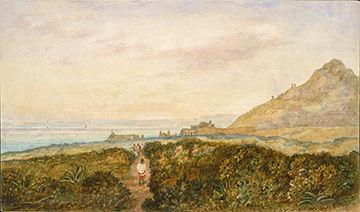A bit of digging recently unearthed some little-known but quite exciting Wairarapa colonial history. Some ancient Māori settlement, inter-tribal warfare, shipwrecks, a whaling station, a constitutional drama, whaling romances, a port for the district and our first European disaster all focused on the little bay known these days as Whatarangi, but in earlier times called Te Kopi. It was named after the groves of Karaka trees, planted by early Māori settlors nearby. It was a very busy place in the 1840’s.
Te Kopi was the arrival point in 1841 for many of the Ngāti Kahungunu people returning home to their turangawaewae after their earlier retreat north to the Mahia peninsula because of the threats of war from Te Rauparaha and his allies. They were led back from Mahia by the great chief Pehi Tu-te-pakihi-rangi and soon re-established gardens and villages around the coast and up the Wairarapa Valley. Te Kopi remained a place of significant Māori population for the next decade after which the focus of the population shifted to Turanganui, just south of present day Pirinoa.
Māori had for many years utilized the Te Kopi anchorage and beach for their canoes, and in past times there were extensive gardens and Māori villages all along the Palliser Bay Coast. The frost-free coastal climate and plentiful resources in the sea and bush sustained some of Aotearoa’s first settlors, dating perhaps from the time of Kupe’s visit around the tenth century. So, Te Kopi was a natural place for the Ngāti Kahungunu people to return to.
The first Christian church services and baptisms in the Wairarapa were held at Te Kopi in about August 1843 by the Episcopalian Reverend Cole who walked around the coast from Wellington at the request of the Māori then based at Te Kopi. He had some competition however, as nearby villages were quick to adopt Catholic and Wesleyan faiths, as the missionaries from these faiths came into the Wairarapa from 1844.
For a time from 1845, Te Kopi was a missionary base for the Church Mission Society missionary William Colenso, who preached to audiences of over 300 people in the chapel that was built for him at Te Kopi. Richard Taki was the “native teacher” based there, a very good friend of Colenso. The unruly whalers even sought the permission of Colenso to marry their Māori partners at the Whaling Station.
Whaling was big business in Cook Strait in the 1830’s with many ships of all nationalities taking part in the “bonanza”. The “Right” and “Sperm” whales were targeted first and later the humpback whale as whales became scarcer. It was inevitable that the agrarian focused British settlors would at least for a time from 1840 become involved. By 1850 the bonanza days were over. As the naturalist Ernst Dieffenbach wrote: “The shore whalers, in hunting the animal in the season when it visits the shallow waters of the coast to bring forth the young, and suckle it in security, have felled the tree to obtain the fruit, and have taken the most certain means of destroying an otherwise profitable and important trade.” “Rape and Pillage” were the order of the day as it had been earlier with the seals!
A twenty-seven-year-old colonial entrepreneur from Tasmania, John Wade, explored the Palliser Bay Coast from August 1841 in an effort to recover the cargo of the wrecked Tasmanian whaling boat “David”. The ship was blown ashore at the Muka Muka rocks in a storm in August 1841, and its cargo of valuable barrels of whale oil and whale bone were strewn along the shoreline of Palliser Bay. The larger American whaler the “Elbe” was similarly wrecked in the same spot in December 1841. So, young John Wade was very busy recovering all the cargo from these ships, and in the course of doing so discovered the sheltered little harbor known then as Te Kopi and the Ruamāhanga River. Wade made friends with the returning Māori folk and got the idea of setting up a whaling station there. Compiled by Joe Howells and Mate Higginson



